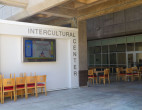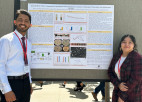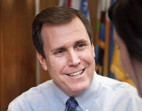SACRAMENTO – Gov. Edmund G. “Jerry” Brown Jr. took the oath of office Monday as Governor of California and delivered his inaugural address in the Assembly Chamber. The address serves as the Governor’s constitutionally required annual report to the Legislature.
Edmund G. Brown Jr.
Inaugural Address
Remarks as Prepared
January 5, 2015
Members of the Legislature, the Judiciary, Constitutional Officers, the extended family of my pioneering ancestors and fellow Californians:
An inauguration is always a special occasion but today it is particularly special as I think about that day 40 years ago when my father and mother watched me take the oath as California’s 34th governor. It is also special because of how far we have come in the last four years. Then, the state was deep in debt – $26 billion – and our unemployment rate was 12.1 percent. Now, the state budget, after a decade of fiscal turbulence, is finally balanced – more precariously than I would like – but balanced. California has seen more than 1.3 million new jobs created in just four years and the unemployment rate has dropped to 7.2 percent. Thanks goes to the Legislature for cutting spending, the economy for recovering and the people for voting for temporary taxes.
We also have the people to thank for Propositions 1 and 2, which save water and money and prepare us for an uncertain future. These are measures that nearly every Democrat and Republican voted to put on the ballot and nearly 70 percent of voters ultimately approved. And I’m proud to report that as a result, by the end of the year, we will be investing in long overdue water projects and saving $2.8 billion in the state’s new constitutionally protected Rainy Day Fund.
And we’re not stopping there. Soon we will make the last payment on the $15 billion of borrowing made to cover budget deficits dating back to 2002. We will also repay a billion dollars borrowed from schools and community colleges and another $533 million owed to local governments.
California has made bold commitments to sustain our environment, help the neediest and build for our future. We are leaders in renewable energy and efficiency; we have extended health care to millions; we are transforming our educational and criminal justice systems; we are building the nation’s only high-speed rail system; we raised the minimum wage; we are confronting the drought and longer-term water issues; and last, but not least, we have enacted real protections for our hardworking immigrants, including the issuance of long-awaited driver’s licenses.
In 2011, we were handed a mess and through solid, steady work, we turned it around. While we have not reached the Promised Land, we have much to be proud of.
As I embark upon this unprecedented fourth term as governor, my thoughts turn to a time long ago when I first entered this chamber, January 5, 1959, for my father’s inauguration. I sat there in front of the rostrum, next to my 81-year-old grandmother, Ida Schuckman Brown, feeling awkward in my priestly black suit and Roman collar. My perspective was different then. The previous August, as a young Jesuit living in what was then a pre-Vatican II seminary, I had taken vows of poverty, chastity and obedience. To me, the boisterous crowd, the applause, the worldliness of it all was jarring.
That was 56 years ago, yet the issues that my father raised at his inauguration bear eerie resemblance to those we still grapple with today: discrimination; the quality of education and the challenge of recruiting and training teachers; the menace of air pollution, and its danger to our health; a realistic water program; economic development; consumer protection; and overcrowded prisons.
So you see, these problems, they never completely go away. They remain to challenge and elicit the best from us.
To that end, over the next four years – and beyond – we must dedicate ourselves to making what we have done work, to seeing that the massive changes in education, health care and public safety are actually carried out and endure. The financial promises we have already made must be confronted honestly so that they are properly funded. The health of our state depends on it.
Educating the next generation is fundamental to our collective well-being. An issue that has plagued our schools for decades is the enormous barrier facing children from low-income families. When my father was governor, he sought to remedy the wide inequities among different school districts by calling for equalization of funding. His efforts were not successful.
Now – decades later – we have finally created a much fairer system of school funding, called the Local Control Funding Formula. Under the provisions of this law, state funds are directed to school districts based on the needs of their students. Districts will get significantly more funds based on the number of students from foster care, low-income families and non-English-speaking parents. This program also breaks with decades of increasing centralization by reducing state control in favor of local flexibility. Clear goals are set, and their enforcement is entrusted to parents and local officials. This puts California in the forefront of educational reform.
After years of underfunding and even borrowing from our local schools, the state now has significantly increased its financial support for education. Next year schools will receive $65.7 billion, a 39 percent increase in four years.
The tasks ahead are daunting: making sure that the new system of local control works; recruiting and training tens of thousands of teachers; mastering the Common Core Curriculum; and fostering the creativity needed to inspire students. Teachers need to be held accountable but never forget: they have a tough job to do. They need our encouragement, not endless regulations and micro-management from afar.
With respect to education beyond high school, California is blessed with a rich and diverse system. Its many elements serve a vast diversity of talents and interests. While excellence is their business, affordability and timely completion is their imperative. As I’ve said before, I will not make the students of California the default financiers of our colleges and universities. To meet our goals, everyone has to do their part: the state, the students and the professors. Each separate institution cannot be all things to all people, but the system in its breadth and diversity, through real cooperation among its segments, can well provide what Californians need and desire.
Along with education, health and human services constitute a major part of what state government does. And in the past few years we have made massive commitments in this area, which will require increasing levels of spending, the full extent of which is not yet known. For example, two years ago California embraced the Affordable Care Act, dramatically increasing its health insurance coverage under the Medi-Cal program. The state will enroll 12.2 million people during this new budget year, a more than 50 percent increase.
Providing the security of health coverage to so many Californians who need it is the right thing to do. But it isn’t free. Although the federal government will temporarily foot much of the bill, new state costs – now and more so in the future – will run into the billions.
Another major state responsibility is our system of crime and punishment. And here too, I will refer to my father’s 1959 address. He worried then about California’s “dangerously overcrowded prisons.” He talked about identifying “those prisoners who should never be released to prey again on an innocent public,” but he also said, “we should also determine whether some prisoners are now kept confined after punishment has served its purpose.”
We face these same questions today: what purposes should punishment serve and for how long should a person be confined to jail or prison – for a few days, a few years or for life?
In response to a large increase in crimes beginning in the 1970s, the Legislature and the people – through ballot initiatives – dramatically lengthened sentences and added a host of new crimes and penalty enhancements. Today, California’s legal codes contain more than 5,000 separate criminal provisions and over 400 penalty enhancements, an arcane and complex mix that only the most exquisitely trained specialist can fathom. And funding has grown proportionately: during the 1970s we had 12 prisons holding fewer than 30,000 prisoners and corrections spending was only 3 percent of the budget; our system then grew to a peak of 34 prisons, with an inmate population of 173,000, eating up more than 10 percent of our budget dollars.
Four years ago, the United States Supreme Court held that our prisons were unconstitutionally overcrowded and imposed strict capacity limits, far below the number of inmates that were then being held.
Clearly, our system of crime and punishment had to be changed. And through the courts, the Legislature and the voters themselves, a number of far-reaching reforms have been enacted. The biggest reform is our realignment program, which places tens of thousands of lower-level offenders under county supervision. More recently, a federal three-judge panel ordered further measures to reduce prison overcrowding. And the voters, through Propositions 36 and 47, modified our criminal laws to reduce the scope of the Three Strikes law and change certain felonies into misdemeanors.
All these changes attempt to find less expensive, more compassionate and more effective ways to deal with crime. This is work that is as profoundly important as it is difficult, yet we must never cease in our efforts to assure liberty and justice for all. The task is complicated by our diversity and our divisions and, yes, by shocking disparities. Since time immemorial, humankind has known covetousness, envy and violence. That is why public safety and respect for law are both fundamental to a free society.
As we oversee these important changes to education, health care and public safety, we must not lose sight of our long-term liabilities. We have to face honestly the enormous and ever growing burden of the many commitments we have already made. Among these are the costs of pensions and retiree health care, the new obligations under the Affordable Care Act, the growing government costs of dealing with our aging population, bonded indebtedness and the deferred maintenance on our roads and other infrastructure. These specific liabilities reach into the hundreds of billions of dollars.
My plan has been to take them on one at a time. We have now taken steps to deal with the unfunded teachers’ pensions and those of the public employees. For the next effort, I intend to ask our state employees to help start pre-funding our retiree health obligations which are rising rapidly.
We must also deal with longstanding infrastructure challenges. We are finally grappling with the long-term sustainability of our water supply through the recently passed Proposition 1 and our California Water Action Plan.
Equally important is having the roads, highways and bridges in good enough shape to get people and commerce to where they need to go. It is estimated that our state has accumulated $59 billion in needed upkeep and maintenance. Each year, we fall further and further behind and we must do something about it.
So I am calling on Republicans and Democrats alike to come together and tackle this challenge. We came together on water when many said it was impossible. We came together – unanimously – to create a solid Rainy Day Fund. We can do it again.
Finally, neither California nor indeed the world itself can ignore the growing assault on the very systems of nature on which human beings and other forms of life depend. Edward O. Wilson, one of the world’s preeminent biologists and naturalists, offered this sobering thought:
“Surely one moral precept we can agree on is to stop destroying our birthplace, the only home humanity will ever have. The evidence for climate warming, with industrial pollution as the principal cause, is now overwhelming. Also evident upon even casual inspection is the rapid disappearance of tropical forests and grasslands and other habitats where most of the diversity of life exists.” With these global changes, he went on to say, “we are needlessly turning the gold we inherited from our forebears into straw, and for that we will be despised by our descendants.”
California has the most far-reaching environmental laws of any state and the most integrated policy to deal with climate change of any political jurisdiction in the Western Hemisphere. Under laws that you have enacted, we are on track to meet our 2020 goal of one-third of our electricity from renewable energy. We lead the nation in energy efficiency, cleaner cars and energy storage. Recently, both the Secretary-General of the United Nations and the President of the World Bank made clear that properly pricing carbon is a key strategy. California’s cap-and-trade system fashioned under AB 32 is doing just that and showing how the market itself can generate the innovations we need. Beyond this, California is forging agreements with other states and nations so that we do not stand alone in advancing these climate objectives.
These efforts, impressive though they are, are not enough. The United Nations’ Intergovernmental Panel on Climate Change, backed up by the vast majority of the world’s scientists, has set an ambitious goal of limiting warming to 2 degrees Celsius by the year 2050 through drastic reductions of greenhouse gases. If we have any chance at all of achieving that, California, as it does in many areas, must show the way. We must demonstrate that reducing carbon is compatible with an abundant economy and human well-being. So far, we have been able to do that.
In fact, we are well on our way to meeting our AB 32 goal of reducing carbon pollution and limiting the emissions of heat-trapping gases to 431 million tons by 2020. But now, it is time to establish our next set of objectives for 2030 and beyond.
Toward that end, I propose three ambitious goals to be accomplished within the next 15 years:
Increase from one-third to 50 percent our electricity derived from renewable sources;
Reduce today’s petroleum use in cars and trucks by up to 50 percent;
Double the efficiency of existing buildings and make heating fuels cleaner.
We must also reduce the relentless release of methane, black carbon and other potent pollutants across industries. And we must manage farm and rangelands, forests and wetlands so they can store carbon. All of this is a very tall order. It means that we continue to transform our electrical grid, our transportation system and even our communities.
I envision a wide range of initiatives: more distributed power, expanded rooftop solar, micro-grids, an energy imbalance market, battery storage, the full integration of information technology and electrical distribution and millions of electric and low-carbon vehicles. How we achieve these goals and at what pace will take great thought and imagination mixed with pragmatic caution. It will require enormous innovation, research and investment. And we will need active collaboration at every stage with our scientists, engineers, entrepreneurs, businesses and officials at all levels.
Taking significant amounts of carbon out of our economy without harming its vibrancy is exactly the sort of challenge at which California excels. This is exciting, it is bold and it is absolutely necessary if we are to have any chance of stopping potentially catastrophic changes to our climate system.
California, since the beginning, has undertaken big tasks and entertained big ideas. Befitting a state of dreamers, builders and immigrants, we have not hesitated to attempt what our detractors have called impossible or foolish. In the last four years, in the last 40 years, yes ever since Gaspar de Portola in 1769 marched along the King’s Highway, California has met adversity with faith and courage. We have had setbacks and failures, but always in the end, the indomitable spirit of California has triumphed. Through it all, through good times and bad, California has been blessed with a dynamism and historic trajectory that carries each generation forward.
Whether the early explorers came for gold or God, came they did. The rest is history: the founding of the Missions, the devastation of the native people, the discovery of gold, the coming of the Forty-Niners, the Transcontinental Railroad, the founding of great universities, the planting and harvesting of our vast fields, oil production, movies, the aircraft industry, the first freeways, the State Water Project, aerospace, Silicon Valley and endless new companies and Nobel Prizes.
This is California. And we are her sons and daughters.
Yes, California feeds on change and great undertakings, but the path of wisdom counsels us to ground ourselves and nurture carefully all that we have started. We must build on rock, not sand, so that when the storms come, our house stands. We are at a crossroads. With big and important new programs now launched and the budget carefully balanced, the challenge is to build for the future, not steal from it, to live within our means and to keep California ever golden and creative, as our forebears have shown and our descendants would expect.
Like this:
Like Loading...
Related




 Tweet This
Tweet This Facebook
Facebook Digg This
Digg This Bookmark
Bookmark Stumble
Stumble RSS
RSS


























REAL NAMES ONLY: All posters must use their real individual or business name. This applies equally to Twitter account holders who use a nickname.
2 Comments